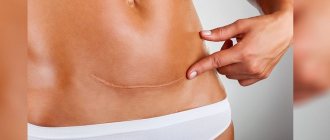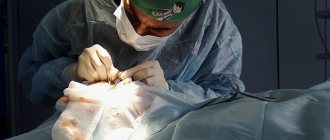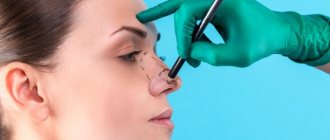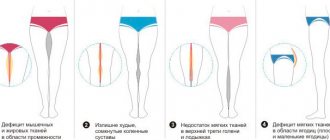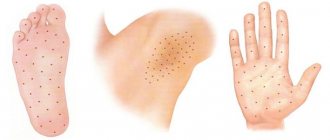What types of sympathectomies are there?
In medical practice, it is customary to distinguish such operations according to the localization of the surgical intervention:
- Total sympathectomy, during which the sympathetic trunk itself is excised over a significant extent.
- Ganglectomy – removal of the sympathetic ganglion.
- Truncular - resection of the border part of the trunk located between the two ganglia.
- Periarterial - during the operation, the outer shell of the arterial wall is excised along with the nerves located in it.
- Splanchnicectomy – resection of the celiac nerve.
- Laparoscopic – retroperitoneal lumbar surgery. Prescribed as a radical method of treating obliterating endarteritis and nonspecific arthritis, obliterating vascular sclerosis of the lower extremities, and diabetic angiopathy. PTPS of the deep veins can be regarded as a relative indication.
In addition, there are three types of operations, each of which has its own level of trauma:
- Endoscopic: the safest and non-traumatic method.
- Open: the most traumatic method, after which the patient needs a long rehabilitation, and surgical scars remain on the skin.
- Percutaneous: The surgeon cannot visually monitor the progress of the operation, so some errors may occur during the procedure.
If the operations do not involve complete resection of the sympathetic nerves, then they are called sympathictomy. The nerve is compressed, but not permanently excised.
General information about sympathectomy
Sympathectomy
is a surgical intervention whose purpose is to stop
the transmission of nerve impulses using sympathetic nerve fibers.
This is possible thanks to the option of clipping or dissecting the sympathetic nerve trunk. This technique is used not only to eliminate hyperhidrosis. In 1921, lumbar sympathectomy was performed in the treatment of arterial vascular insufficiency of the lower extremities. Since the 1950s, surgical dissection of the nerve trunk has been used to treat hyperhidrosis of a wide variety of locations.
IMPORTANT: Sympathectomy is a surgical procedure whose purpose is to stop the transmission of nerve impulses using sympathetic nerve fibers.
Sympathectomy performed for hyperhidrosis: possible consequences of the operation
This procedure has virtually no significant complications, and even if they manifest themselves, it will only extend the hospital stay by a few days.
The most serious complication of sympathectomy used to relieve hyperhidrosis of the upper and lower extremities is Horner's syndrome, which occurs when the first intrathoracic sympathetic node is damaged. Doctors call this structure the stellate ganglion. It is from this that the sympathetic nerves go to the face and eyes. Signs of Horner's syndrome are expressed in moderate ptosis and miosis, when the upper eyelid is slightly drooping and the pupil is reduced in size.
A drooping eyelid can be corrected using blepharoplasty, but if the surgeon follows the correct procedure for performing the operation, then the likelihood of developing such consequences is reduced to almost zero. In practice, this complication is very rare, but on specialized forums you can find reviews from patients who have encountered this problem.
The next problem is the complete ineffectiveness of the method. In rare cases, if we do not take into account patients with severe adhesions in the pleural cavity, after the procedure, hyperhidrosis of the lower and upper extremities remains, and the symptoms may even intensify. This effect occurs due to additional pathways, the so-called Kunz nerves.
If preliminary diagnostics showed the presence of such formations, then during the operation they must be found and destroyed. Thus, this complication is completely eliminated. And yet, reviews from patients with a similar pathology are disappointing - almost all of them experienced a return of sweating after 10-12 months. This problem mainly concerns those who have undergone clipping of the sympathetic trunk.
The essence of sympathectomy
The sweat glands present in the body begin active production of biological fluid only after receiving a certain signal from the sympathetic part of the nervous system. At the moment the transmission path of this signal is interrupted, sweating stops.
To achieve this effect, two options can be considered:
- Injection of botulinum toxin to treat hyperhidrosis, which involves chemically blocking signal transmission
- Surgical sympathectomy, in which nerve trunks are surgically dissected or surgically blocked
Indications and contraindications
Effectiveness is based on the elimination of the pathological impulse, which is transmitted from the lesions and causes persistent foci of excitation in the central nervous system. After sympaiectomy, the vessels in the area of the desympathized area are forced to dilate, so most often a similar surgical technique is used for diseases accompanied by vascular spasms.
Indications for the procedure include autonomic pain syndrome, trophic ulcers, pathologies and circulatory disorders in the periphery, for example, in the lower extremities. Prescribed for obliterating endarteritis, hyperhidrosis, Raynaud's disease, erythromelalgia. Based on data from postoperative examinations and reviews from the patients themselves, we can say that after the intervention, vascular spasm is relieved, swelling of the lower extremities is reduced, the intensity of pain and sweating is reduced, and ulcers heal much faster.
Thoracoscopic sympathectomy is characterized by minimal complications. If a percutaneous technique is used, the surgeon may touch and damage blood vessels, and the endoscopic procedure helps prevent such consequences. The operating doctor sees exactly where he needs to advance the instrument.
Laparoscopic surgery is not performed for severe obesity. Since highly developed adipose tissue greatly complicates the release of the sympathetic trunk.
Such an intervention is strictly contraindicated in patients diagnosed with secondary hyperhidrosis. And also for chronic hyperthyroidism, since it is necessary to treat the main problem, and not its consequences. The procedure is strictly contraindicated for any form of pulmonary and heart failure, tuberculosis, emphysema and pleurisy.
Immediately before surgery, the patient must undergo the following tests:
- Blood for clinical and biochemical tests.
- Total protein and urea.
- For bilirubin, cholesterol, AST, ALT, creatinine, glucose.
- For blood clotting.
- I'm going to urinate for a general analysis.
- RW, HIV, blood for hepatitis B and C.
- Determination of blood group and Rh factor.
- Electrocardiography.
Blood biochemistry is indicative only for 14 days, all other tests - 30 days.
Get rid of sweaty palms and armpits forever
Sympathectomy should be considered as the definitive treatment for sweating of the palms and armpits. After surgery, reversal methods are controversial, just as drug treatment for compensatory sweating is not completely effective. Therefore, the main problem has ceased to be operative aggressiveness and has become the selection of patients who would benefit most from reduction of hyperhidrosis with a lower likelihood of complications.
The diagnosis of hyperhidrosis is made using clinical criteria based on personal history and clinical examination. There is no specific laboratory diagnosis for hyperhidrosis or imaging test (no radiation methods are applicable) to confirm. It should be excluded whether it is secondary to another condition (secondary hyperhidrosis, for example, due to neuropathies or hormonal disorders).
Clinical criteria are the presence of visible patchy sweating for at least 6 months, without any other obvious cause, consistent with at least two of the following criteria:
- bilateral and symmetrical,
- affecting daily activities,
- happening more than once a week,
- starting before age 25,
- family history of hyperhidrosis and absence of night sweats.
- Sweating is clearly influenced by emotional status and stressful situations.
Special instruments exist to measure sweat volume, but they are impractical for clinical use, only as research equipment and can only be used in the laboratory.
Initial treatment of primary hyperhidrosis is conservative. If the patient receives relief from their symptoms without limiting side effects, they will avoid invasive treatment. Local therapy is initially suggested, but may only be effective in milder cases.
Iontophoresis can lead to temporary improvement of palmar and plantar hyperhidrosis, but it has low adherence because it takes time to achieve results and because of its temporary nature.
Botulinum toxin injection also addresses the problem of hyperhidrosis with temporary results. This is an expensive treatment with an average LOS of less than 1 year and may satisfy patients prone to repeated injections.
However, some patients who experience the hyperhidrosis-free period offered by temporary localized treatment will seek something more specific.
Excision of the sympathetic trunk as a way to combat hyperhidrosis
Endoscopic sympathectomy has a number of certain advantages when compared with other surgical operations and conservative therapy. This is the most effective treatment for excessive sweating. After such manipulations, 95% of patients can be relieved of hyperhidrosis and erythrophobia.
Thoracic sympathectomy is absolutely safe because it is low-traumatic. Due to the classical procedure of excision of the sympathetic nerves, the patient is usually forced to remain in bed for approximately 7 days, and endoscopic sympathectomy allows him to leave the hospital within a few hours. Sweating in the upper and lower extremities will disappear within a few days, and in the armpits - no earlier than in a week. This is a definite advantage of any video-assisted thoracoscopic interventions.
Endoscopic thoracic sympathectomy is used to get rid of erythrophobia, when the face turns red at the slightest emotional outburst, as well as to relieve complex regional pain syndromes of the extremities, for example, causalgia and reflex sympathetic dystrophy.
Indications
Sympathectomy is performed if the use of drugs that reduce sweating is for some reason impossible.
This minimally invasive operation is indicated for severe hyperhidrosis or excessive sweating of the palms, when other treatment methods have been ineffective.
Thoracic endoscopic sympathectomy is indicated in two cases:
- the patient has complications caused by hyperhidrosis (skin maceration or secondary infection);
- the patient has difficulties in daily activities, for example, he cannot work at work.
In these cases, both of the following criteria must be present:
- the use of aluminum chloride or other extra strong antiperspirants is contraindicated, poorly tolerated or ineffective;
- there are contraindications or intolerance, or the patient refuses to take tablet drugs that reduce sweating - anticholinergics, beta blockers, benzodiazepines.
Sometimes sympathectomy is used for social reasons, for example, with facial flushing during public speaking, as well as with Raynaud's syndrome. It may be used for bromhidrosis, although this condition is usually treated successfully non-surgically. Sympathectomy may also help patients with olfactory nerve syndrome, Moyamoya disease, persistent headaches, bronchial hyperresponsiveness, and long QT syndrome. However, in all these cases only a small number of observations are presented, and such indications are the subject of scientific and clinical research rather than widespread practice.
Lumbar endoscopic sympathectomy is used to treat excessive sweating of the feet.
Clipping of sympathetic trunks as an analogue of a full-fledged sympathectomy
The procedure must be performed under general anesthesia. Once the patient falls asleep, the surgeon makes punctures in the chest area. A thin tube is inserted into these cavities, which is equipped with a light source and a video camera. The image will be displayed on a monitor screen located directly in front of the surgeon’s eyes. An instrument will be inserted through the punctures. The surgeon controls all manipulations on the sympathetic trunk and places a special clip on it. In this way, a certain area of the nerve is pinched, which ultimately makes it possible to reduce sweating in the area of the upper and lower extremities.
Excision of the sympathetic trunk is no less effective, but irreversible. And if the surgical intervention provokes compensatory hyperhidrosis in the patient, nothing can be done about it. People who have undergone the clipping procedure give good reviews about its results. Punctures can also be made in the armpits, due to which the postoperative scars remaining at the site of single sutures will be practically invisible.
Preparatory stage
Particular attention is paid to the preoperative preparation of the patient, which involves undergoing a thorough examination using standard diagnostic methods:
- collection of urine and blood for clinical analysis;
- blood chemistry;
- determination of the patient’s blood type and blood rhesus;
- analysis for HIV infection, hepatitis, syphilis, etc.
- In addition, fluorographic examination is provided, as well as electrocardiogram monitoring.
Some procedures are required before surgery. These include taking blood for analysis.
Progress of surgery
A standard operation requires the mandatory use of epidural anesthesia or intubation anesthesia. The patient is placed in the same position as for retroperitoneal discectomy, then the surgical field is prepared for surgery.
The incision is made parallel to the convergence of the oblique and rectus abdominis muscles, closer to the umbilical cavity. The depth of the cut is 10 mm. This allows you to define 1 port in order to insert the endoscope.
You can also read:Surgery to remove lumbar disc herniation
At the initial stage, the surgeon performs digital enucleation of the retroperitoneal space. The fascia is then separated using a balloon dissector. If the cavity formed is large enough, the balloon is removed and a 2nd port for surgical instruments is installed. Sometimes during the operation a retractor is used, which is inserted into the operated cavity after the formation of 1 port.
After opening the tissues of the retroperitoneal space, 2 trocars are additionally introduced, which facilitate the surgeon’s work. Next, the retractor peels away the muscles from the peritoneum and retroperitoneal tissue, which provides access to the ganglia and sympathetic fibers.
At the final stage, the sympathetic ganglia are separated with a dissector. First, the sympathetic trunk is dissected with its simultaneous elevation above the nearby tissues, then the sympathetic trunk branches are dissected, followed by the isolation of the sympathetic ganglia.
Contraindications to the procedure
Before deciding to use surgery, the doctor must assess all possible risks of treatment.
Direct contraindications to the operation are:
- diabetic diseases of any severity;
- pathological disturbances in the functioning of the endocrine system;
- infectious and inflammatory diseases;
- development of secondary hyperhidrosis;
- severe pulmonary emphysema and pleurisy;
- presence in the patient's medical history of surgical intervention on the abdominal organs;
- symptoms of heart and respiratory failure.
During the operation, sympathetic fibers are clipped
In addition, allergy testing is mandatory to avoid possible complications during the operation of cutting (clipping) the sympathetic fiber.
Who is the operation indicated for?
Having understood what sympathectomy is, it is worth learning in more detail about who is prescribed this type of surgical intervention. She has few indications, and they are all associated with excessive activity of the sympathetic nervous system.
The operation is performed in the following cases:
- primary hyperhidrosis not associated with other diseases;
- Raynaud's disease - damage to the small vessels of the hands, manifested by spasm of the fingers, swelling, cyanosis and the formation of trophic ulcers;
- Blushing syndrome - intense redness of the face that occurs with any manifestation of emotion;
- Sudeck's syndrome is a post-traumatic pain syndrome with severe trophic disorders of the limbs.
Before a sympathectomy, a thorough examination of the patient is carried out in order to confirm its necessity and identify any deviations in health that may affect the course of the operation and the course of the postoperative period.
How does sympathectomy affect hyperhidrosis?
Sympathectomy directly disables the ability of the sweating mechanisms to operate. After all, the cessation of the functioning of part of the nerve trunk responsible for transmitting signals from the body’s thermoregulation system does not allow information about a particular state of the skin area to reach the brain. In this case, the brain will always be sure that the areas of skin that concern the patient do not require sweating at all. And even if such information reaches him, he will not be able to send a signal to suitable glands. Thus, there is no more reliable way to solve the problem of hyperhidrosis.
Lumbar sympathectomy for atherosclerosis of the lower extremities
Lumbar sympathectomy is a palliative treatment for diseases of the blood supply to the extremities, accompanied by ischemia, intermittent claudication and trophic disorders. The method allows you to improve blood circulation without interfering with the main vessels.
Lumbar sympathectomy for atherosclerosis of the lower extremities
- Atherosclerosis of the lower extremities
- Trophic ulcers of the legs
- Diabetic macroangiopathy
- Endarteritis, etc.
Sympathectomy itself implies the exclusion of the nerve nodes responsible for the narrowing of peripheral vessels from the normal functioning.
Previously, such interventions were part of arterial interventions or were performed independently. For this purpose, open surgery methods were used, and the access itself was performed under general anesthesia.
Considering that the sympathetic nodes lie on the anterior surface of the spine, the surgeon had to go quite deep. As a result, there were complications from anesthesia, surgical access, from a long hospital stay, and so on.
Today, a modified sympathectomy technique is used for atherosclerosis of the lower extremities. It is carried out under the control of a computed tomograph.
Doctors precisely and very accurately puncture the area of the node. Next, a neurolytic drug is directly administered, which completely turns off the node from normal functioning.
Administration of a neurolytic drug
The consequence of this procedure is to disable the constricting effect on the vessels. As a result, the vessels dilate and fill with blood.
We see the first effects in the first 30 minutes. The legs begin to warm up, the pain syndrome decreases, and the blood supply to the extremities improves.
Indications for sympathectomy surgery are some diseases of the arteries and some diseases of the veins with trophic changes.
First of all, this technique is used for patients who cannot undergo open bypass surgery or arterial replacement.
The fact is that the method refers to indirect vascularization and the main arteries are not involved in this situation.
The sympathetic node is located in close proximity to large vessels such as the aorta and inferior vena cava. Therefore, this method of treatment is accompanied by the risk of bleeding.
The next contraindication is nerve root injury. It all depends on accuracy. If a nerve root is damaged, sensitivity may be lost. As a rule, pain syndromes do not occur.
Also, given that various drugs are used in this procedure, anaphylactic reactions may develop. Mainly for local anesthetics. Individual reactions to iodine and iodine-containing drugs used during the procedure may also develop.
Risk side effects may also include damage around underlying organs such as the renal pelvis, ureters, and so on. Infection is also a risk. Therefore, the procedure requires execution under aseptic conditions.
Pneumothorax is also a risk. Occurs when there is work on high-lying sympathetic nodes. Or it occurs in the case of significant spinal deformities such as scoliosis, spinal hernia, and so on.
In some cases, neuralgia occurs along the nerve root and neuropathies along the anterolateral surface of the thigh may occur. This phenomenon goes away on its own within 2 to 3 months.
In the case of a complete block of sympathetic nodes on both sides, men may experience symptoms of dry orgasm and ejaculation disorders.
Who can we not perform sympathectomy on and what are the contraindications? If the patient has foci of chronic infection (infected gangrene or ulcers), then due to the risks of spreading infections, such a procedure is very dangerous.
If the patient has had a stroke or heart attack within the next three months, there is a risk of relapse. In this case, the person is first taken to rehabilitation and only after that this procedure is carried out.
If the patient has claustrophobia, then he should be immediately warned that a long stay in a confined space is required. Therefore, given the possibility of panic attacks, not every doctor will be able to admit such patients to treatment.
Patients with grade 3 heart failure may have cardiac decompensation. Therefore, doctors will not perform surgery for this type of pathology.
There is also a ban in case of allergic reactions to drugs used during the procedure.
It is also a contraindication if you are taking anticoagulant drugs. For example, Fraxiparin, Clexane, Warfarin, Xarelto, Prodaxa, etc. After all, then the procedure will be associated with significant bleeding and the formation of hematomas.
Let's look at the advantages of sympathectomy for atherosclerosis of the lower extremities. In normal clinics, this method is considered minimally invasive. Therefore, it has a fairly large number of advantages over open surgery.
Atherosclerosis
Firstly, there is a lack of extensive surgical access. Accordingly, the number of infections that are predicted for the patient is significantly less. There is also no anesthesia and its risks. The procedure itself is performed under local anesthesia.
The procedure itself does not require much preparation, except that doctors ask the patient not to eat in advance. And in case of any manifestations of fear or nervousness, doctors ask that sedatives be taken in advance.
Now let's talk a little about the course of the lumbar sympathectomy operation. Typically, the patient is placed in a supine position into the CT scanner. Next, doctors mark the spinous processes of the lumbar vertebrae, conduct an initial scan and mark the area where the needle and guidewire are inserted.
Marking the piercing area
After this, puncture is performed with a needle, control of the administration of the antipsychotic drug and control of the node entering the zone of destruction.
After the procedure, with which patients can leave on their own, doctors conduct additional research. They note how effective the operation was.
After the procedure, the limb should become warmer. There should be a feeling of filling of the veins and pain should decrease. As a rule, after sympathectomy for atherosclerosis of the lower extremities, this effect occurs in almost all patients.
Thus, if there is a need to restore blood circulation, sympathectomy can only be used as an additional method of treatment. And given that it gives good results, overall treatment results can improve significantly.



